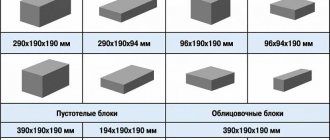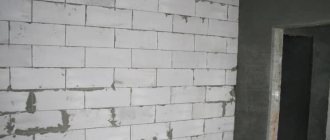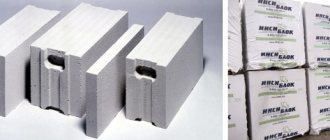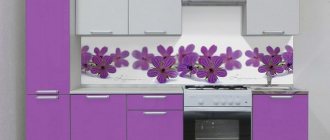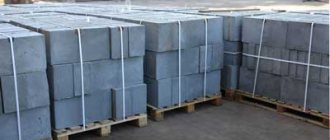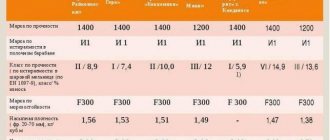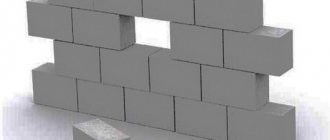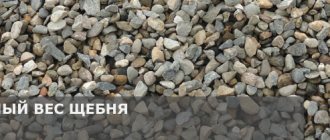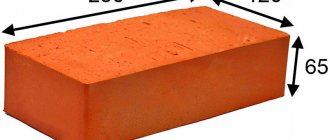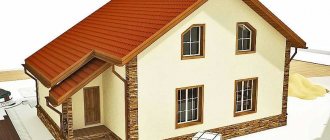Arbolite blocks are used for the construction of low-rise buildings.
They are one of the safest and most environmentally friendly materials that do not harm human health or the environment. Arbolite is not subject to fires and rotting. As for thermal conductivity, when laying wood concrete the thickness required is 3 times less than for a brick wall.
Arbolite blocks are a reliable option for construction, which will allow you to save on material, but at the same time provide a reliable living space.
Wood concrete weight 1 m3. How many wood concrete blocks are in a cube?
2018-01-19 17:56+0000Russian Arbolite LLC.
Phone, address: Kutuzovsky Prospekt, building 22, Moscow, 121151, Russia How to find out how many wood concrete blocks are in one cube? How can this be calculated? Answer:
To find out how many wood concrete blocks are in a cube, you need to calculate the volume of one block. To do this, multiply the length, width and height of the block in meters. For example, for a standard block 500×300×200 mm:
0.5 * 0.3 * 0.2 = 0.03 m3 (this is the volume of one block)
To find out the number of blocks in a cube, divide one by the volume of the block:
1/0.03=33.3 (number of pieces in one cubic meter)
The most popular sizes of arbolite wall blocks
The most popular sizes of partition arbolite blocks
Why do you need to know the amount of wood concrete in a cube?
- Firstly, manufacturers indicate the price differently - some indicate the cost for one wood concrete block, others the price of a cube. And in order to compare the prices of two manufacturers, it is necessary to bring the cost to a single indicator - the price of a block or cube.
For example, for one manufacturer the price of a block of 500x300x200 mm is 130 rubles, for a second the same block costs 4100 rubles/cubic meter. We multiply the price of a block from the first manufacturer by the quantity per cube and find out how much a cube of wood concrete costs.
130*33.3=4329 rubles
Thus, the second supplier is slightly cheaper.
- Secondly, for the convenience of calculating the required quantity for construction. If you have calculated how many cubic meters of wood concrete you will need, and you need to find out how many blocks it will be.
How much does wall masonry work cost?
The cost of masonry work depends on the conditions in which the masonry will have to be carried out.
Also, the cost depends on the region of residence of the customer.
Moreover, the price for masonry is approximate, since the estimate indicates the volume of work in cubic meters , and it is not easy to accurately calculate cubic meters.
More often the volume of square meters is used and multiplied by 0.3. Thus, an approximate calculation is provided.
For laying arbolite blocks, 2 methods are used. The first is the use of polyurethane foam, a budget and simple solution. The second is more durable and costly - the use of cement mortar. The table shows the average market price for wall laying work .
| Type | Unit | Cost Naberezhnye Chelny | Cost Nizhny Novgorod | Cost Noginsk | Cost St. Petersburg | Cost Krasnodar region |
| Laying arbolite blocks using sand mortar | m3 | 600 | 800 | 800 | 600 | 600 |
How many pieces of wood concrete are in a cube? Standard block 500x300x200
Arbolite blocks of the standard class are preferable for the construction of industrial and residential buildings in central Russia, although a wall with optimal thickness will be able to overcome any frost. A standard wood concrete block maintains temperature without a greenhouse effect, since the material is well ventilated thanks to a structure with a significant number of pores.
Standard arbolite blocks can be laid on the rib surface: 20-25 cm will be enough to recreate the thickness of the walls of any enterprise with a high level of humidity, while the financial benefit will be obvious.
CHARACTERISTICS
| Density | Brand strength | Thermal conductivity | Frost resistance | Moisture absorption | Weight | PC. cubed | PC. on a pallet | |
| Standard block 500 x 300 x 200 mm | Density 550-650 kg/m3(D600) | Grade strength M25 (B1.5) | Thermal conductivity 0.12 W/(mS) | Frost resistance F50 | Moisture absorption 60% | Weight 19 kg | PC. cubed 33.3 | PC. on pallet 48 |
Laying a standard wood concrete block
The blocks are laid in the traditional way, as it will be sufficient to provide thermal insulation in various climatic conditions.
The laying composition can be varied: traditional cement, perlite-based, concrete adhesive. The thickness of each layer of the mixture is about 2-5 mm, which ensures high stability, allows you to save money and form a neat seam, as well as prevent the appearance of “cold” bridges Price: 5000 rub.
How many cubes of wood concrete are needed for a house? We calculate arbolite blocks for the house and cube walls
After we have bought a ready-made standard one or ordered an individual project for a future house from an architect, we will need to perform an additional calculation to determine the required number of wood concrete sides.
This will help us determine the cost of the material and the scope of work for the overall construction. From the project we know exactly how many cubes of blocks we will need, and how many blocks in one cube still need to be counted. Arbolite is an excellent alternative to standard concrete and brick. The material has increased thermal insulation, strength and durability. It is chosen to facilitate the construction process, since the construction of a house requires much less volume when compared with other building materials. Before you buy blocks, you need to calculate the required quantity. There are many calculators on the Internet, but in order to perform the calculation correctly, you need to understand how it works.
If the design was carried out by a professional, then you should already know what materials will be used in construction.
The two sizes most commonly used are:
- 500x300x200 mm - for load-bearing walls.
- 500x150x120 mm - for partitions.
Sometimes you can find projects with blocks 400x200x200 mm. Without complete project documentation, you will not be able to find out how much wood concrete is needed for a house. It is also recommended to find out in advance how much square footage the doorways and windows take up. If this stage has already been completed, you can begin calculations.
Approximate calculation of how much wood concrete is needed for a house
To perform the calculation, you need to know the length of all load-bearing walls of the future building. We also need to know the thickness of the walls, this indicator is the same almost everywhere - load-bearing walls have a thickness of 300 mm, and interior partitions - 150 mm. The next parameter that is needed in the calculations is the height of each floor. In order for the calculations to be accurate, it is necessary to know the general square footage of windows and doorways.
The number of blocks is calculated according to the following scheme:
- It is necessary to calculate the perimeter of the house; to do this, the length of all the walls must be added up - this will be the total length.
- To get the total height, add the height of each floor.
- Next, we multiply the total height of the building by the total length of the load-bearing walls.
- From the resulting amount, subtract the area of window and door openings.
- The result obtained should be multiplied by the number of blocks required for laying 1 m2 of wall.
- Done, now you know how many blocks your house will need.
For example, you can take a standard 6x6 m house:
- total length of walls - 36 m;
- total height of walls - 9 m;
- total area of windows and doors - 11 m2;
- we use blocks 500x300x200 mm - to build 1 m2 of wall you will need 10 pieces. such blocks.
Now the calculation:
Nblocks per house=(36*9 –11)*10=3130 pcs.
In this example, we neglect the masonry seam so that we have a supply of building material in the region of 5–7% for additional blocks and scrap. And of course, we simplified the numbers for the sake of the example.
As you can see, having a plan for the future construction, you can independently calculate how much wood concrete you will need for your house. This way you can save money and check the contractors. If you are planning to hire workers, then it would be useful to double-check how much work they will include in your estimate.
How many blocks are in one cube?
For further calculations, you also need to know how many blocks are in one cube. First, let's look at the standard material for load-bearing walls with a size of 500x300x200 mm - 33.3 pieces in one cube.
Above, we carried out the calculation and found out that for a standard 6x6 construction, 3130 pieces are needed, now let’s convert this figure into volume:
Vpage material=3130/33=95 m3.
Separately, you need to find out the volume for bulkheads for which wood concrete is used 500x150x200 mm, in one cube of which there are 66.6 pieces. Also in construction, wood concrete with a size of 400x200x200 is used - in this case there will be 62 pieces in 1 m3.
We have given examples so that you understand how the calculation of wood concrete blocks per house is carried out. To make this step easier, you can use a special construction calculator - you will only need to indicate the basic data that we have listed. But calculators usually show only the basic dimensions, and your construction may use blocks of a different size.
Information on the purpose of the calculator
Online building block calculator
designed to perform calculations of building materials necessary for the construction of walls of houses, garages, utility and other premises. The calculations can take into account the dimensions of the building's gables, door and window openings, as well as related materials, such as mortar and masonry mesh. Be careful when filling out the data, pay special attention to the units of measurement.
When filling out the data, pay attention to the additional information with the Additional information sign
Technologies do not stand still, including construction technologies. For the construction of walls, wood has been replaced by brick, and today its place is increasingly being taken by building blocks obtained artificially, and depending on the raw materials used, they can have different characteristics.
Building blocks are popular in the construction of low-rise buildings and walls of monolithic frame buildings. They can not only be used to build external walls, but can also be used for internal partitions and interior walls. Concrete blocks are also suitable for making prefabricated foundations for light buildings.
The advantages of building blocks are obvious. With their help, you can build a building in a short time without the use of special equipment. They have good thermal insulation and the necessary strength. Therefore, the funds spent on insulation will be significantly lower than when building with brick. And if we compare building blocks with wooden log houses, then this means not only less additional funds and work, but also a higher durability of the building.
Blocks do not need such a strong vapor barrier as, for example, wood. Considering their dimensions and lightness, even the foundation for such a house will cost much less than brick and reinforced concrete. The use of special masonry adhesive increases the thermal insulation of the walls and makes them more attractive in appearance.
Building blocks can be divided into two types:
- Artificial
- Natural
– they are obtained by mixing concrete of different compositions in factories using special vibroforming machines. The resulting material, depending on the raw material, has the required strength, density and thermal insulation properties.
– are comparatively more expensive than those offered by the factory. They are obtained by careful processing and grinding of rocks. Most often they are used as decorative finishing of facades.
Artificial building blocks include: aerated concrete, foam concrete, expanded clay concrete, polystyrene concrete, sawdust concrete and many others. Each type is used depending on the required qualities, and has both a number of advantages and a number of disadvantages. One type has good thermal insulation properties, but they are somewhat inferior in strength (if we compare, for example, aerated concrete and expanded clay concrete). In any case, buildings constructed using building blocks require less time to construct turnkey houses, compared to the same wooden log houses, which require a lot of time to finally dry out and settle. And only after this can the final finishing of the room begin.
When building from blocks, interior decoration can be done immediately after construction is completed.
Based on their design features, building blocks are divided into:
- Structural
- Structural and thermal insulation
- Thermal insulation
They are used for the construction of load-bearing walls of buildings. They have high strength, but also high thermal conductivity and heavy weight. In this regard, when constructing residential premises, additional insulation is required.
They are used for the construction of load-bearing walls of low-rise buildings. They have average characteristics, both in strength and thermal insulation qualities. Ideal for residential premises with seasonal use.
They are used for the construction of only self-supporting walls, such as internal partitions and walls of frame buildings, as well as for insulating load-bearing walls. They have low thermal conductivity, low weight, but also low strength.
Unfortunately, at the moment there is no ideal material that has high levels of all the necessary characteristics at once, such as low thermal conductivity, high strength, low weight and cost. And in each specific case, it is necessary to choose exactly the material that is most suitable for the planned construction, taking into account the necessary requirements.
The cost of finished walls is approximately equal to 1/3 of the cost of the entire building.
The following is a complete list of calculations performed with a brief description of each item. If you have not found the answer to your question, you can contact us using the feedback located in the right block.
Composition of wood concrete per 1 cubic meter. Material Specifications
The second name of the material is wood concrete or wood block, it received due to the presence of a large amount of wood in it. Arbolite blocks include 90% wood chips - preferably coniferous. But they cannot be perceived as a complete analogue of wood - wood concrete is standardized exactly like concrete or building stone.
The technical characteristics of wood concrete combine the properties of wood and cement, which makes it stand out even among its analogues - foam concrete and aerated concrete.
At a minimum, in terms of thermal conductivity, ease of processing and installation, wood concrete is significantly superior to brick.
Material characteristics in the table:
| Property | Values |
| Density (how much a cubic meter of material weighs), kg/m3 | 500-850 |
| Compressive strength (required force to compress the block), MPa | 0,5-3,5 |
| Bending strength (required force to bend the block), MPa | 0,7-1 |
| Thermal conductivity (the lower the better), W/(m*C) | 0,08-0,17 |
| Modulus of elasticity (ability to compress without deformation), MPa | 250-2300 |
| Frost resistance (how many times a wet block can be frozen) | 25-50 |
| Water absorption (absorbed water relative to weight), % | 40-85 |
| Shrinkage (change in size after installation), % | 0,4-0,5 |
| Biostability (the more the better), group | V |
| Fire resistance (time before material destruction in fire), min | 45-90 |
| Sound insulation (percentage of transmitted sounds up to 2000 Hz),% | 0,17-0,6 |
Many characteristics of a material depend on its density, which varies due to the use of different types of cement and fillers. This primarily affects density and thermal conductivity.
It is impossible to change the water absorption parameters, but to reduce them, as with other materials, plastering of walls or decorative facade panels is used.
What affects the cost per cube and piece?
If a manufacturing company uses a high cost, then they independently purchase wood chips for their production. In this case, the manufacturer purchases cuttings of the boards and splits them themselves using a wood chipper.
At an average cost, the manufacturer finds free wood chips from the wood processing complex. After processing the logs, a slab remains, which is used for wood concrete blocks.
It is beneficial for the timber processing complex when enterprises offer to take away waste from processing logs , since it is impossible to store them; during storage, the wood begins to rot. Manufacturers negotiate with the timber processing complex to remove residues, often free of charge.
If a manufacturing enterprise operates a sawmill in parallel, then they use their own materials, through which they ensure a free, constant supply of waste. In this situation, the company can afford to reduce prices by saving on the supply of wood chips.
Also, the price indicator depends on the geographical location of the enterprise.
Most wood processing complexes are located in the northern part of Russia, so in the south of Russia, due to the difficulty of supplying wood chips, purchasing is much more expensive .
Only large enterprises that make wholesale purchases can save on cement. Since cement must be of proper quality, it is not possible to save significantly on it.
Small enterprises can also afford to make bulk purchases of cement at a time, but with a long period of idle time, cement loses its properties, and if the enterprise bought M400 cement, and it was stored for six months after production, then its properties are equal to M300 cement.
Much of the cost of wood concrete blocks depends on the premises of the production enterprise. If an organization is the owner of a building, then it can reduce the cost of blocks by saving on renting premises.
Large enterprises that are provided with a constant flow of orders can afford equipment of a higher class. It increases productivity by almost 5 times. Small enterprises use equipment of a lower class , accordingly producing 5 times fewer parts.
Installing serious equipment in small enterprises is unprofitable, since simpler equipment can be operated by one person, while high-end machines require several people. And this increases labor costs.
| Type of wood concrete block | Unit | Cost Naberezhnye Chelny | Cost Nizhny Novgorod | Cost Noginsk | Cost St. Petersburg | Cost Krasnodar region |
| 200x300x500 for walls and gables | Cubic Meters | 4000 | 4200 | 4500 | 4800 | 4500 |
| 200x300x500 for armored belt and jumpers (U-shaped) | 1 PC. | 200 | 210 | 200 | 230 | 250 |
| 200x150x500 for internal partitions | Cubic Meters | 4400 | 4600 | 4500 | 4800 | 4300 |
| 250x300x500 for walls | Cubic Meters | 3600 | 3500 | 3500 | 3800 | 3800 |
